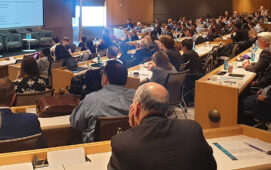Working Group 11 (WG11) of Subcommittee 4 (SC4) of the ISO Technical Committee 68 (TC68) has released a consultation document seeking comment on it first iteration of a data model that “provides a single standard for describing a financial instrument throughout its lifecycle.” The group, formed earlier this year, is seeking comment from industry participants on definitions of all securities data elements and their relationships with each other with the aim of helping financial institutions “integrate multiple data sources, feed diverse applications and add functionality.”
Accuracy and integrity
The new consultation document was released May 1, and follows a paper put out in March outlining the new working group’s raison d’etre (Reference Data Review, April 2004). With the latest paper, WG11 hopes to put in place what it terms “the information architecture foundation” – providing standardized names, values and formats for all data elements, referred to by WG11 as “terms, definitions and relationships (TDR).” WG11 says this architecture foundation is required “to ensure the accuracy and integrity of a financial instrument throughout its lifecycle – as the logical basis of the reference data strategy within financial organizations.”
As reported, WG11 is working from a business model approach used by Working Group 10 in its development of an XML edition of the ISO 15022 standard. It also will embrace the Market Data Definition Language (MDDL) market data vocabulary sponsored by the Financial Information Services Division (FISD) of the Software & Information Industry Association.
In its latest consultation document, WG11 goes to great lengths to stress the importance of industry participants in the process. Because the lifecycle of an instrument involves so many diverse functions – from issuance through asset servicing, as WG11 puts it – the working group is seeking to involve as many industry participants as possible in order to draw upon their expertise across the broad array of processes involved.
Lifecycle processes
The paper formalizes presentation and expands upon the lists of the various functions and data elements initially outlined by WG11 in a basic matrix agreed at the group’s inaugural meeting in January. The matrix maps transaction lifecycle processes against market data applications segmented by the categories Set-up, Price and Maintain. The initial five transaction lifecycle processes in the matrix has been expanded to include:
· Issuance
· Pre-Trade
· Trade
· Allocation
· Clearing
· Margining
· Settlement
· Collateral Management
· Reconciliation
· Registration
· Transfer of Ownership
· Foreign Exchange
· Valuation
· Performance Management
· Reporting
· Corporate Actions
· Analyze Risk
· Modelling
The Set-up category of market data applications, comprising all data required to set up securities master files, now includes 10 characteristics:
· Identification
· Classification
· Rights and Obligations
· Cash Flows
· Capital Investment
· Appearance/Form
· Issuer/Agent Information
· Listing Information
· Trade Information
· Status
The Price category, including all data about the monetary value of financial instruments, contains seven characteristics:
· Security Identification
· Time of Price
· Source of Price
· Price Status
· Market Identification
· Price Type
· Appearance/Form
Finally, the Maintain category, including all data required to keep a financial instrument up to date, now features seven characteristics:
· Corrections/Updates
· Issuer/Agent/Trustee
· Exchange/Marketplace
· Regulatory/Government
· Rating Agency
· Holders
· Corporate Actions
From this published matrix, the group hopes to derive feedback that will allow it to refine its definitions of TDRs. “The challenge here,” the group notes, “is to determine whether the categories are defined with enough specificity to cover the full range of applications.” The full white paper is available from the FISD web-site at http://www.fisd.net.
Subscribe to our newsletter





